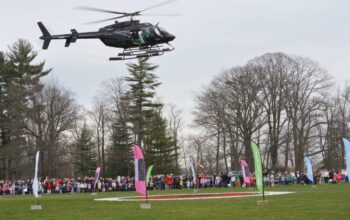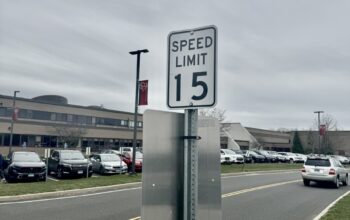Molly Keshin, Sports Editor
@mollykCourant
Scrolling down your Facebook feed, you often see endless posts of people with their friends or hilarious videos. But then, an interesting picture catches your eye: a bird’s eye shot of the beach with the sun setting off in the

distance, and you can see a city that seems to be miles away. At first glance, you think it is just another artsy picture that somebody took through an airplane window. However, the high definition and breathtaking quality of the shot is not from an ordinary camera, it was taken on a drone.
A drone, by definition, is any aircraft or ship that can navigate autonomously without direct human control. Upon hearing this word, most people automatically think of the pre-programmed planes that carry war weapons, yet personal camera drones are now becoming popular for recreational use. In fact, drones are now in such a high demand that NCHS Career and Tech Education teachers Roman Cebulski and Jim Zambarano have decided to follow the trend by obtaining a drone earlier this year with the help of seniors Peter

Lavieri and Connor DeMayo as well as junior Scotty Luntz, who are all a part of the NCTV program.
Two years ago, Mr. Cebulski and Mr. Zambarano were approached by LifeTouch, a school portrait company, which offered to do a flyover of NCHS and its athletic facilities. However, at the time, the logistics did not fit when the option was passed up to administration as drones were less prevalent. This past year, in return for renewing a three-year contract with LifeTouch, the school was given a budget of around $3,000 to purchase a drone of their choice due to increased interest from students.
Because drones come in several different shapes, sizes and models, Connor dedicated a couple of weeks of TV Broadcasting class to research what drone would be the best quality considering the amount of money they were allotted for the project. “We ended up choosing the DJI Phantom 3 Professional, even though there are four other DJI Phantom drones to choose from, plus higher level DJI drones, plus other companies,” Connor said. “It is pretty much different variations of camera quality and then the range of the drone itself, and the DJI Phantom 3 Pro shoots 4k and has a range that can go up to two, even five, kilometers. There is just a lot of drones out there, and you have to choose one model that works best for your situation.”

Another feature of the DJI Phantom 3 Pro is its three-axis gimbal, which allows for the camera to stay level while the drone is flying and tilting in order to have a clear, stabilized shot. While there are several other elements of the drone that impress Mr. Zambarano, such as its ability to recognize its relative location to the
remote control with a GPS system, he believes that the superior camera quality is going to be most beneficial for the students and programs that will use it. “We mainly see this being used in the TV program to expand the program and compose pictures with professional quality, which gives us more options to do other things, cinematically and stylistically,” Mr. Zambarano said. “You used to need a boom or a large scaffolding that you’d set up for the kind of video that we now want to shoot, which would cost thousands of dollars to set up to shoot football games. The drone allows you to get those same shots at a fraction of the cost and it is easy to set up.”
As the TV Broadcasting teacher, Mr. Cebulski is excited to add a whole new perspective and creative aspect to the program that is now possible thanks to the drone. “We really have two main goals to achieve with the drone, and the first thing is to get more interesting and compelling shots that we could never get before that kids can use in actual video projects,” Mr. Cebulski said. “The other thing that we want to do is find a way so that we can take a live feed from a drone and put it into a broadcast. For example, in the morning announcements, it would

be cool if we could cut to a drone shot when the weather person is talking about what’s going on that to give a little more movement to the weather segment. Also, for football games at Dunning Stadium, we would like to take a drone shot and put it into the live feed so that it would go on the scoreboard.”
Because drones are only becoming popular now despite their release in the mid-2000s, there are very few restrictions that regulate the activities of users. “Connecticut has no specific state laws, so we only have to follow the national laws, which are really more like recommendations for safety put forth by the Federal Aviation Administration,” Connor said. “Stay below 400 ft is the most important one, but others are also don’t fly within five miles of an airport and if you do you have to let them know that you are doing it and get permission, keep it within line of sight the whole time so you have to have visual contact with it, and do not fly in a crowded area.”
Scotty, who owns a couple of DJI model drones as well as a 3DR Solar drone, enjoys using his drones but feels that the restrictions are becoming more strict and are therefore impacting the extent to which he can use them. “When I see a cool shot, I see a good sunset, when I see a mountain, I will bring it and fly it as high and far as I can to get the best shot I can get and then I’ll edit the video and put it on Youtube,” Scotty said. “When I first started out, there were not really any regulations so it was pretty easy to go anywhere without the police questioning you. But it is becoming much more difficult to go into state parks and state-owned areas to fly, so drone users are really starting to take a big hit.”
While Mr. Cebulski and Mr. Zambarano are excited about the addition of the drone to their classes, they feel as though in its early stages it is important to limit how and to what extent students can use it. “Currently, we have set up steps that students have to watch certain videos first, they have to take it out with myself or Mr. Cebulski,

and we feel that even any time the students need to use it there needs to be some faculty member present,” Mr. Zambarano said. “It is another great educational tool that allows kids to go further and I can see it being opened up to everybody with training, but as of right now I think limiting it to the TV, Yearbook and Journalism classes is best because we can see that application.”
Even though the decision process in terms of training students is still in its early stages, Mr. Cebulski feels as though it is one of the most vital part of the procedure because handling a drone requires a lot of responsibility. “For us right now it’s not only learning the technology, but also certain things that we need to make sure kids know before they go out and use it,” Mr. Cebulski said. “It is not just like video camera where you take it, you learn it quickly, and you go. It is very intricate and it is an expensive device, so we want to make sure that kids are well-trained before they use it. We’re thinking of having some sort of training certificate that kids will get after they go through training, and maybe there will be some kind of test or a quiz at the end so they understand all the different features and limitations of a drone.”
Peter has recently used drones to film a documentary project on public safety, but he feels that there are more possibilities to use drones in the future besides videos and pictures. “For our school, it is a serious investment that was made, but now that we have it, I think the sky’s the limit,” he said. “You can have a drone club, you ca

n use it for all sorts of different projects, and it is just a cool hobby to have. I do not think there is too much downside to having one, but people are going to have to be responsible with it.”
Because there are endless amounts of possibilities in terms of drones’ capabilities, Mr. Cebulski feels that they are going to start to become a much more prevalent part of our world, and that they are here to stay. “Drones are hot right now, and there is a lot of interest in them because they’re both fun to fly recreationally as well as the fact now that you can take the video footage from it and incorporate it into education and other aspects of life,” Mr. Cebulski said. “In broadcasting nowadays, they are hiring professionals that just focus on drones, so it is now a whole other business category for job opportunities for people who are masters of the drone, and it is really exciting.”
Check out the bonus video here! https://www.youtube.com/watch?v=9s2U7XnNBc4



